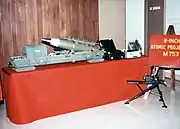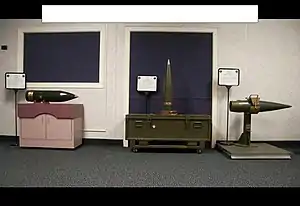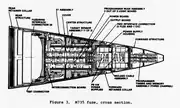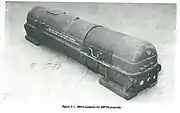W79 Artillery-Fired Atomic Projectile
The W79 Artillery-Fired Atomic Projectile (AFAP),[2] also known as the XM753 (Atomic RA)[3][4] was an American nuclear artillery shell, capable of being fired from any NATO 8 in (203 mm) howitzer e.g. the M115 and M110 howitzer.[5] Produced in two models, the enhanced radiation W79 Mod 0 and fission-only W79 Mod 1. Both were plutonium-based linear-implosion nuclear weapons.
- The Mod 0 was a variable yield device with three yields, ranging from 100 tons of TNT (420 GJ) up to 1.1 kt (4.6 TJ) and an enhanced-radiation mode which could be turned on or off
- The Mod 1 was fission-only with a fixed 0.8 kt (3.3 TJ) yield, corresponding with the maximum fission only yield of the Mod 0
| W79 | |
|---|---|
 An inert M754 training version of the warhead | |
| Type | Nuclear artillery |
| Place of origin | United States |
| Service history | |
| In service | 1981 to 1992 |
| Used by | United States Army |
| Production history | |
| Designer | Lawrence Livermore National Laboratory |
| Designed | 1975 to 1981 |
| Specifications | |
| Mass | 200 pounds (91 kg) |
| Length | 44 inches (1,100 mm) |
| Diameter | 8 inches (203 mm) |
| Maximum firing range | 24 kilometres (15 mi) or 30 kilometres (19 mi) with rocket assist[1] |
| Blast yield | 0.1 to 1.1 kilotonnes of TNT (0.42 to 4.60 TJ) (Mod 0), 0.8 kilotonnes of TNT (3.3 TJ) (Mod 1) |
Both models were 8 in (203 mm) in diameter, 44 in (1,100 mm) long and weighed 200 lb (91 kg). The W79 was developed by Lawrence Livermore National Laboratory, starting in 1975. Production of the different mods took place from July 1981 through August 1986. A total of 550 warheads (325 Mod 0s, 225 Mod 1s) were produced.[6] All units were retired from active service by the end of 1992 with the last shell dismantled at the Pantex Plant in Texas in August 2002.[7]
Design
The weapon had a range of 24 kilometres (15 mi) or 30 kilometres (19 mi) with rocket assist.[1]
The weapon utilized the M735 proximity fuze. It contained a dual-channel fuze system, target sensor, electronic programmer and power supply.[8] Its design goals were to minimize overall weight, minimize structural volume, eliminate the use of potting materials for structural support, and to eliminate cable and wire harnesses.[9] The goal of not using potting materials was ultimately not met.[10]
The fuze was developed with an extensive test firing program and in service use would have experienced a 10,400 g0 (102,000 m/s2) setback acceleration and 11,400 revolutions per minute (190 Hz) spin.[11] Some test units experienced setbacks of 15,300 g0 (150,000 m/s2).[12]
Gallery
 W79 AFAP on display.
W79 AFAP on display. W79 AFAP on display (right).
W79 AFAP on display (right). Diagram of the M735 fuze.
Diagram of the M735 fuze. W79 (XM753) nuclear artillery projectile in its storage container
W79 (XM753) nuclear artillery projectile in its storage container
References
- Sandia Weapon Review: Nuclear Weapon Characteristics Handbook (PDF) (Report). Sandia National Labs. September 1990. p. 75. SAND90-1238. Archived (PDF) from the original on 2022-01-12.
- "W79 Artillery-Fired Atomic Projectile (AFAP)". Archived from the original on 2021-02-01. Retrieved 2021-01-28.
- Henry E Hudgins (January 1977). Aerodynamics, Dimensions, Inertial Properties and Performance of Artillery Projectiles (PDF) (Report). Picatinny Arsenal. p. 4. Archived (PDF) from the original on 2021-12-19. Retrieved 2021-12-24.
- Thomas B Cochran; William M Arkin; Milton M Hoenig (1984). Nuclear Weapons Databook, Volume I: US Nuclear Forces and Capabilities (PDF) (Report). Natural Resources Defense Council. p. 77. Archived (PDF) from the original on 2021-09-01. Retrieved 2021-12-24.
- LLNL achievements in the 1970s
- Hansen, Chuck (2007). The Swords of Armageddon, version 2. Chukelea Publications. pp. VI-521, VI-522.
- Workers Dismantle Final U.S. Nuclear Artillery Shell
- Miller, John M.; Boring, Steven A. (1979-05-01). Structural Firing Tests of the M735 Proximity Fuze (Report). HARRY DIAMOND LABS ADELPHI MD. p. 6. Archived from the original on 2021-12-24. Retrieved 2021-12-24.
- Structural Firing Tests of the M735 Proximity Fuze, p. 8.
- Structural Firing Tests of the M735 Proximity Fuze, p. 37.
- Structural Firing Tests of the M735 Proximity Fuze, p. 5.
- Structural Firing Tests of the M735 Proximity Fuze, p. 25.
External links
- Allbombs.html list of all US nuclear weapon models at nuclearweaponarchive.org
- Linear Implosion in the Nuclear Weapons FAQ at nuclearweaponarchive.org